A Critical Review: Sexting, Sexual Behavior, and Young Adults
VerifiedAdded on 2023/06/12
|6
|1267
|315
Literature Review
AI Summary
This critical review examines the phenomenon of sexting among young adults, focusing on its prevalence, associated socio-demographic characteristics, and relationship with sexual behavior and psychological well-being. It identifies four categories of sexting participants: non-sexters, senders, receivers, and two-way sexters. The review notes that while technology and social media have increased opportunities for sexual encounters, the direct correlation between sexting and psychological well-being remains unclear, with conflicting research findings on its impact on mental health. It highlights gender differences in sexting behavior, with males more likely to be receivers and the potential for sexting to influence negative beliefs about women. The review concludes that sexting's connection to riskier or safer sexual behavior is not definitively established and calls for further research to fully understand its implications.

Running head: CRITICAL REVIEW 1
Critical Review
Name
Institution
Critical Review
Name
Institution
Paraphrase This Document
Need a fresh take? Get an instant paraphrase of this document with our AI Paraphraser
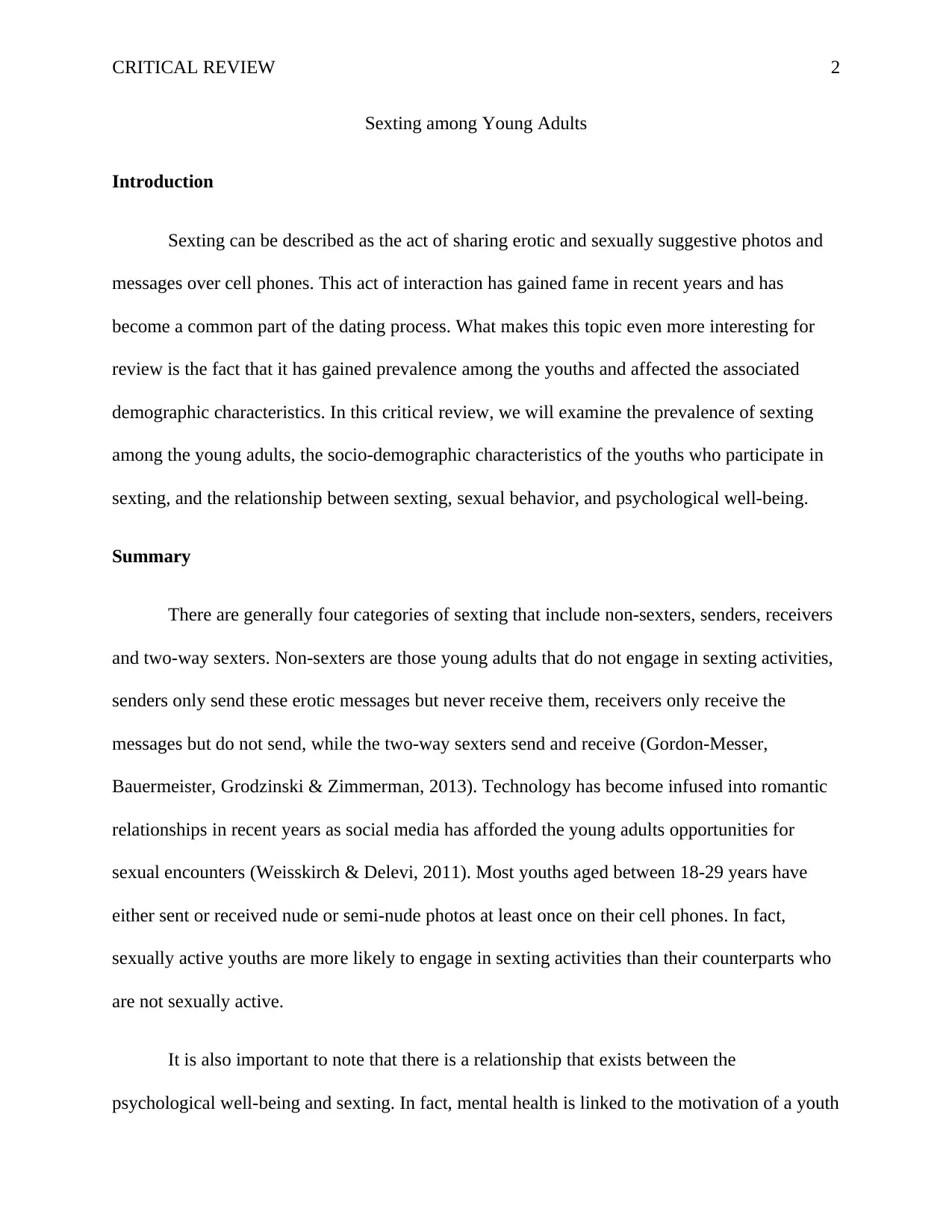
CRITICAL REVIEW 2
Sexting among Young Adults
Introduction
Sexting can be described as the act of sharing erotic and sexually suggestive photos and
messages over cell phones. This act of interaction has gained fame in recent years and has
become a common part of the dating process. What makes this topic even more interesting for
review is the fact that it has gained prevalence among the youths and affected the associated
demographic characteristics. In this critical review, we will examine the prevalence of sexting
among the young adults, the socio-demographic characteristics of the youths who participate in
sexting, and the relationship between sexting, sexual behavior, and psychological well-being.
Summary
There are generally four categories of sexting that include non-sexters, senders, receivers
and two-way sexters. Non-sexters are those young adults that do not engage in sexting activities,
senders only send these erotic messages but never receive them, receivers only receive the
messages but do not send, while the two-way sexters send and receive (Gordon-Messer,
Bauermeister, Grodzinski & Zimmerman, 2013). Technology has become infused into romantic
relationships in recent years as social media has afforded the young adults opportunities for
sexual encounters (Weisskirch & Delevi, 2011). Most youths aged between 18-29 years have
either sent or received nude or semi-nude photos at least once on their cell phones. In fact,
sexually active youths are more likely to engage in sexting activities than their counterparts who
are not sexually active.
It is also important to note that there is a relationship that exists between the
psychological well-being and sexting. In fact, mental health is linked to the motivation of a youth
Sexting among Young Adults
Introduction
Sexting can be described as the act of sharing erotic and sexually suggestive photos and
messages over cell phones. This act of interaction has gained fame in recent years and has
become a common part of the dating process. What makes this topic even more interesting for
review is the fact that it has gained prevalence among the youths and affected the associated
demographic characteristics. In this critical review, we will examine the prevalence of sexting
among the young adults, the socio-demographic characteristics of the youths who participate in
sexting, and the relationship between sexting, sexual behavior, and psychological well-being.
Summary
There are generally four categories of sexting that include non-sexters, senders, receivers
and two-way sexters. Non-sexters are those young adults that do not engage in sexting activities,
senders only send these erotic messages but never receive them, receivers only receive the
messages but do not send, while the two-way sexters send and receive (Gordon-Messer,
Bauermeister, Grodzinski & Zimmerman, 2013). Technology has become infused into romantic
relationships in recent years as social media has afforded the young adults opportunities for
sexual encounters (Weisskirch & Delevi, 2011). Most youths aged between 18-29 years have
either sent or received nude or semi-nude photos at least once on their cell phones. In fact,
sexually active youths are more likely to engage in sexting activities than their counterparts who
are not sexually active.
It is also important to note that there is a relationship that exists between the
psychological well-being and sexting. In fact, mental health is linked to the motivation of a youth
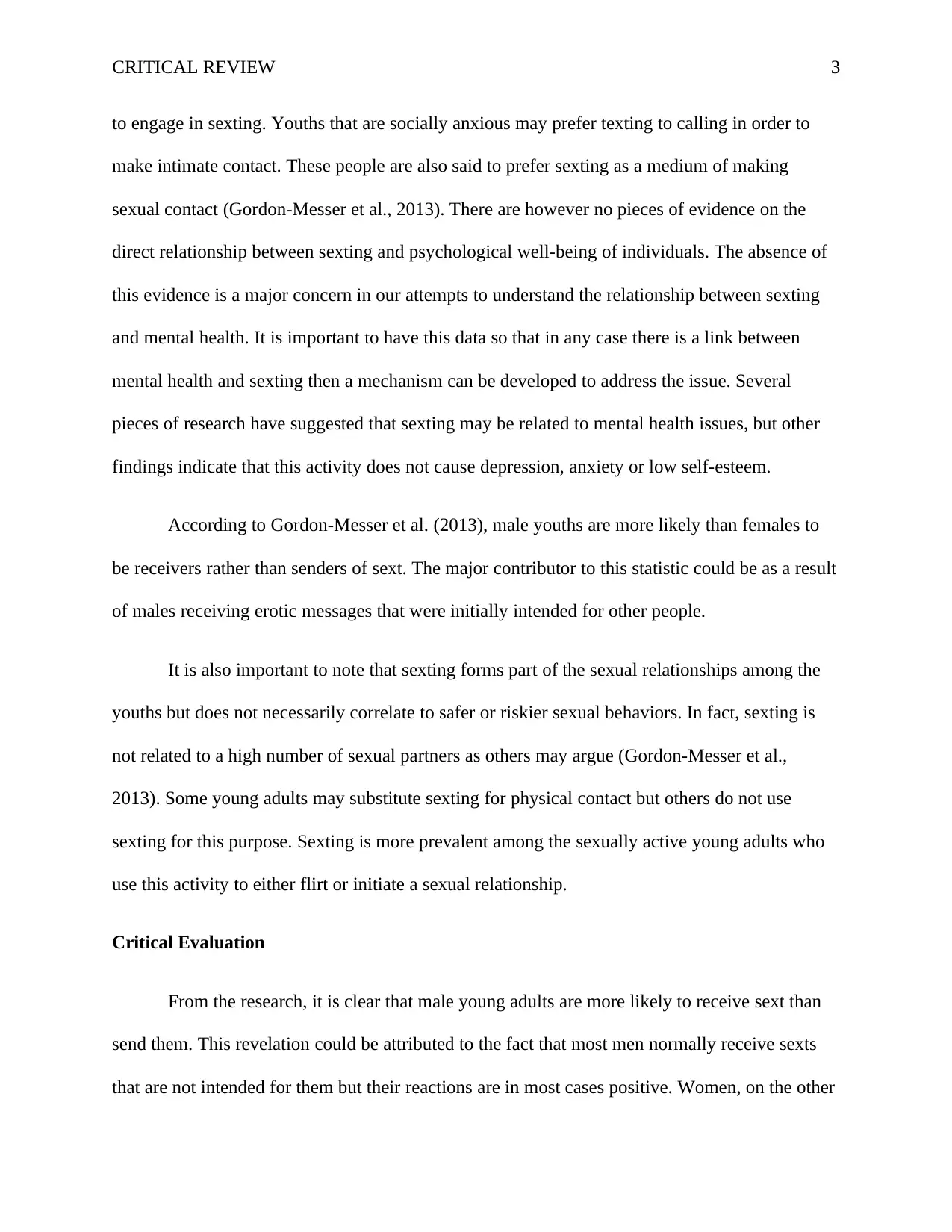
CRITICAL REVIEW 3
to engage in sexting. Youths that are socially anxious may prefer texting to calling in order to
make intimate contact. These people are also said to prefer sexting as a medium of making
sexual contact (Gordon-Messer et al., 2013). There are however no pieces of evidence on the
direct relationship between sexting and psychological well-being of individuals. The absence of
this evidence is a major concern in our attempts to understand the relationship between sexting
and mental health. It is important to have this data so that in any case there is a link between
mental health and sexting then a mechanism can be developed to address the issue. Several
pieces of research have suggested that sexting may be related to mental health issues, but other
findings indicate that this activity does not cause depression, anxiety or low self-esteem.
According to Gordon-Messer et al. (2013), male youths are more likely than females to
be receivers rather than senders of sext. The major contributor to this statistic could be as a result
of males receiving erotic messages that were initially intended for other people.
It is also important to note that sexting forms part of the sexual relationships among the
youths but does not necessarily correlate to safer or riskier sexual behaviors. In fact, sexting is
not related to a high number of sexual partners as others may argue (Gordon-Messer et al.,
2013). Some young adults may substitute sexting for physical contact but others do not use
sexting for this purpose. Sexting is more prevalent among the sexually active young adults who
use this activity to either flirt or initiate a sexual relationship.
Critical Evaluation
From the research, it is clear that male young adults are more likely to receive sext than
send them. This revelation could be attributed to the fact that most men normally receive sexts
that are not intended for them but their reactions are in most cases positive. Women, on the other
to engage in sexting. Youths that are socially anxious may prefer texting to calling in order to
make intimate contact. These people are also said to prefer sexting as a medium of making
sexual contact (Gordon-Messer et al., 2013). There are however no pieces of evidence on the
direct relationship between sexting and psychological well-being of individuals. The absence of
this evidence is a major concern in our attempts to understand the relationship between sexting
and mental health. It is important to have this data so that in any case there is a link between
mental health and sexting then a mechanism can be developed to address the issue. Several
pieces of research have suggested that sexting may be related to mental health issues, but other
findings indicate that this activity does not cause depression, anxiety or low self-esteem.
According to Gordon-Messer et al. (2013), male youths are more likely than females to
be receivers rather than senders of sext. The major contributor to this statistic could be as a result
of males receiving erotic messages that were initially intended for other people.
It is also important to note that sexting forms part of the sexual relationships among the
youths but does not necessarily correlate to safer or riskier sexual behaviors. In fact, sexting is
not related to a high number of sexual partners as others may argue (Gordon-Messer et al.,
2013). Some young adults may substitute sexting for physical contact but others do not use
sexting for this purpose. Sexting is more prevalent among the sexually active young adults who
use this activity to either flirt or initiate a sexual relationship.
Critical Evaluation
From the research, it is clear that male young adults are more likely to receive sext than
send them. This revelation could be attributed to the fact that most men normally receive sexts
that are not intended for them but their reactions are in most cases positive. Women, on the other
⊘ This is a preview!⊘
Do you want full access?
Subscribe today to unlock all pages.

Trusted by 1+ million students worldwide
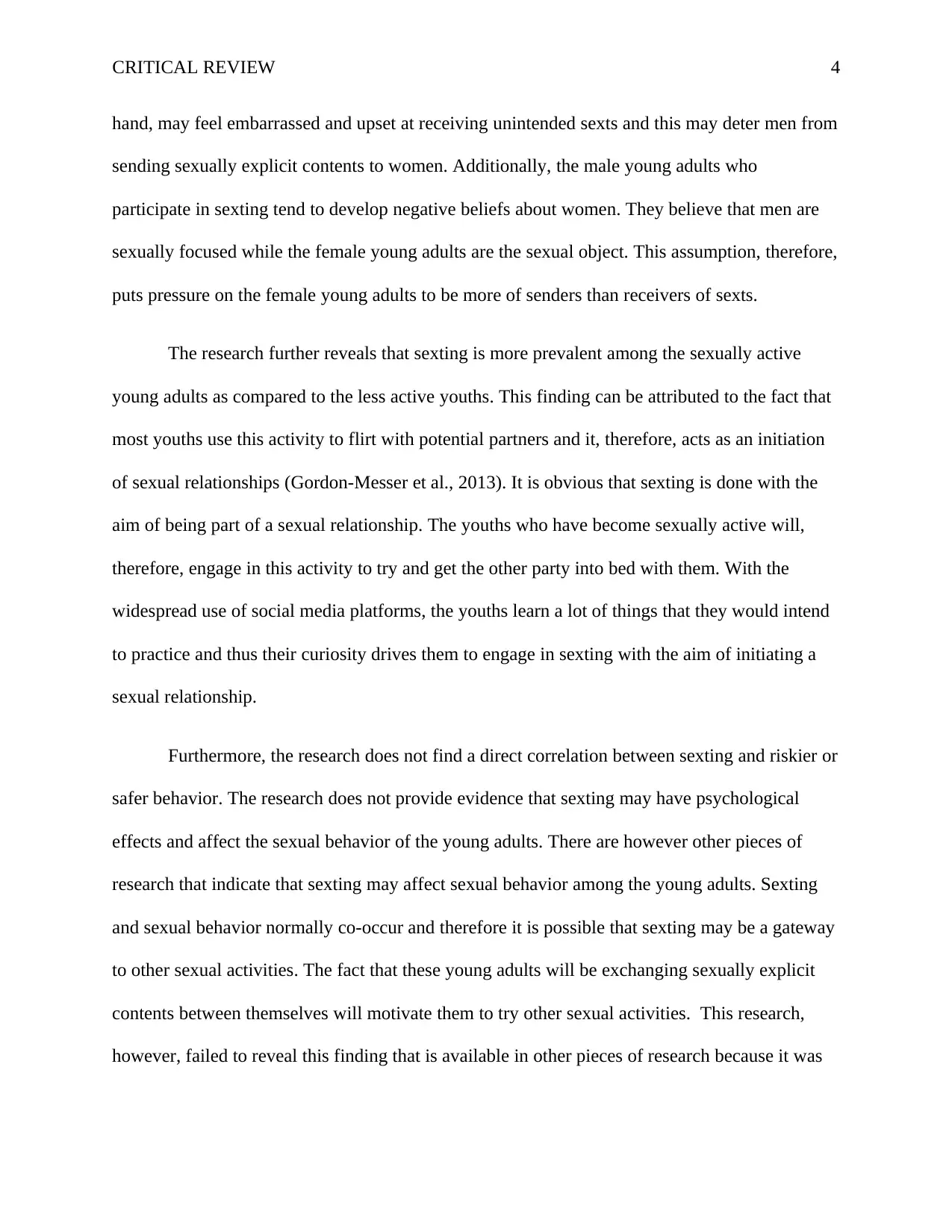
CRITICAL REVIEW 4
hand, may feel embarrassed and upset at receiving unintended sexts and this may deter men from
sending sexually explicit contents to women. Additionally, the male young adults who
participate in sexting tend to develop negative beliefs about women. They believe that men are
sexually focused while the female young adults are the sexual object. This assumption, therefore,
puts pressure on the female young adults to be more of senders than receivers of sexts.
The research further reveals that sexting is more prevalent among the sexually active
young adults as compared to the less active youths. This finding can be attributed to the fact that
most youths use this activity to flirt with potential partners and it, therefore, acts as an initiation
of sexual relationships (Gordon-Messer et al., 2013). It is obvious that sexting is done with the
aim of being part of a sexual relationship. The youths who have become sexually active will,
therefore, engage in this activity to try and get the other party into bed with them. With the
widespread use of social media platforms, the youths learn a lot of things that they would intend
to practice and thus their curiosity drives them to engage in sexting with the aim of initiating a
sexual relationship.
Furthermore, the research does not find a direct correlation between sexting and riskier or
safer behavior. The research does not provide evidence that sexting may have psychological
effects and affect the sexual behavior of the young adults. There are however other pieces of
research that indicate that sexting may affect sexual behavior among the young adults. Sexting
and sexual behavior normally co-occur and therefore it is possible that sexting may be a gateway
to other sexual activities. The fact that these young adults will be exchanging sexually explicit
contents between themselves will motivate them to try other sexual activities. This research,
however, failed to reveal this finding that is available in other pieces of research because it was
hand, may feel embarrassed and upset at receiving unintended sexts and this may deter men from
sending sexually explicit contents to women. Additionally, the male young adults who
participate in sexting tend to develop negative beliefs about women. They believe that men are
sexually focused while the female young adults are the sexual object. This assumption, therefore,
puts pressure on the female young adults to be more of senders than receivers of sexts.
The research further reveals that sexting is more prevalent among the sexually active
young adults as compared to the less active youths. This finding can be attributed to the fact that
most youths use this activity to flirt with potential partners and it, therefore, acts as an initiation
of sexual relationships (Gordon-Messer et al., 2013). It is obvious that sexting is done with the
aim of being part of a sexual relationship. The youths who have become sexually active will,
therefore, engage in this activity to try and get the other party into bed with them. With the
widespread use of social media platforms, the youths learn a lot of things that they would intend
to practice and thus their curiosity drives them to engage in sexting with the aim of initiating a
sexual relationship.
Furthermore, the research does not find a direct correlation between sexting and riskier or
safer behavior. The research does not provide evidence that sexting may have psychological
effects and affect the sexual behavior of the young adults. There are however other pieces of
research that indicate that sexting may affect sexual behavior among the young adults. Sexting
and sexual behavior normally co-occur and therefore it is possible that sexting may be a gateway
to other sexual activities. The fact that these young adults will be exchanging sexually explicit
contents between themselves will motivate them to try other sexual activities. This research,
however, failed to reveal this finding that is available in other pieces of research because it was
Paraphrase This Document
Need a fresh take? Get an instant paraphrase of this document with our AI Paraphraser
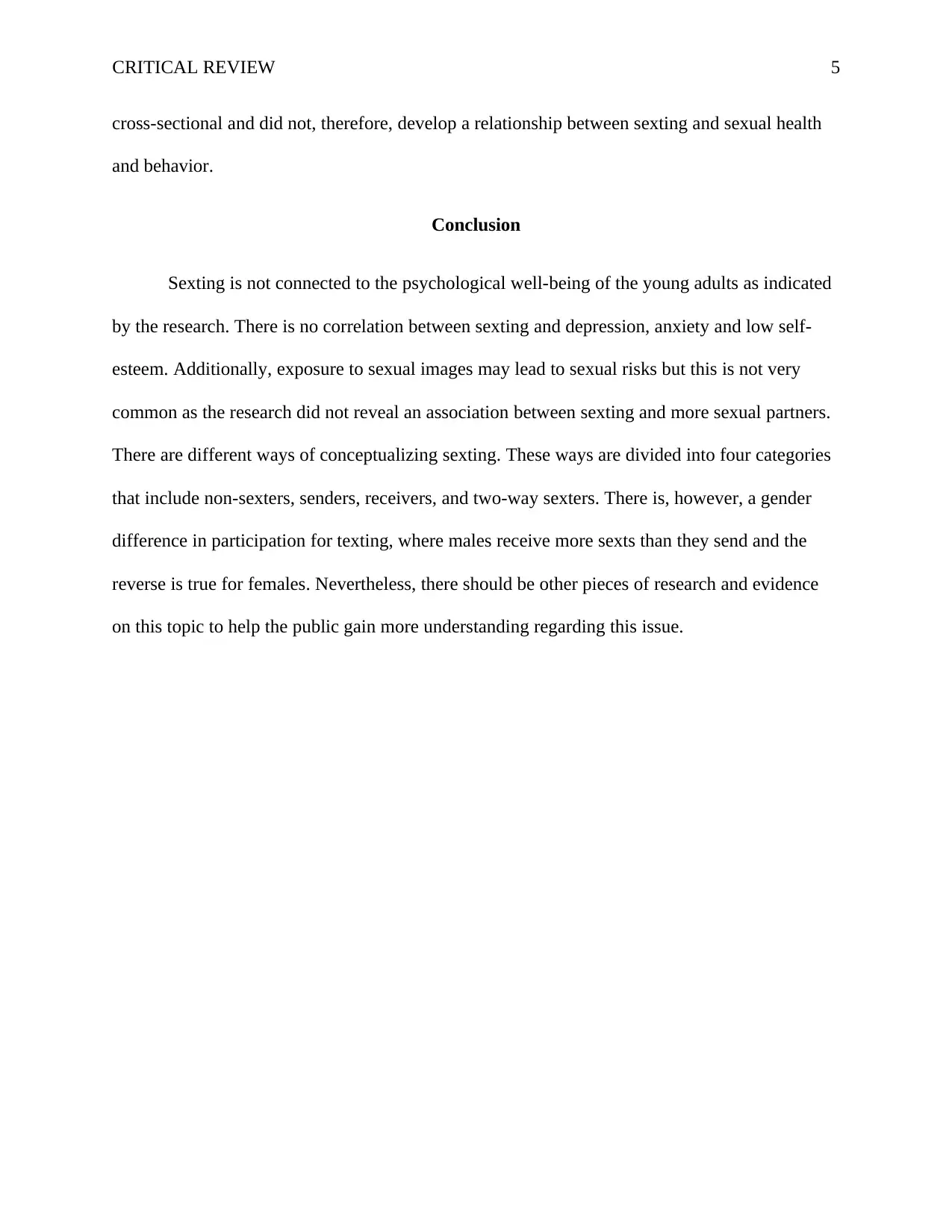
CRITICAL REVIEW 5
cross-sectional and did not, therefore, develop a relationship between sexting and sexual health
and behavior.
Conclusion
Sexting is not connected to the psychological well-being of the young adults as indicated
by the research. There is no correlation between sexting and depression, anxiety and low self-
esteem. Additionally, exposure to sexual images may lead to sexual risks but this is not very
common as the research did not reveal an association between sexting and more sexual partners.
There are different ways of conceptualizing sexting. These ways are divided into four categories
that include non-sexters, senders, receivers, and two-way sexters. There is, however, a gender
difference in participation for texting, where males receive more sexts than they send and the
reverse is true for females. Nevertheless, there should be other pieces of research and evidence
on this topic to help the public gain more understanding regarding this issue.
cross-sectional and did not, therefore, develop a relationship between sexting and sexual health
and behavior.
Conclusion
Sexting is not connected to the psychological well-being of the young adults as indicated
by the research. There is no correlation between sexting and depression, anxiety and low self-
esteem. Additionally, exposure to sexual images may lead to sexual risks but this is not very
common as the research did not reveal an association between sexting and more sexual partners.
There are different ways of conceptualizing sexting. These ways are divided into four categories
that include non-sexters, senders, receivers, and two-way sexters. There is, however, a gender
difference in participation for texting, where males receive more sexts than they send and the
reverse is true for females. Nevertheless, there should be other pieces of research and evidence
on this topic to help the public gain more understanding regarding this issue.
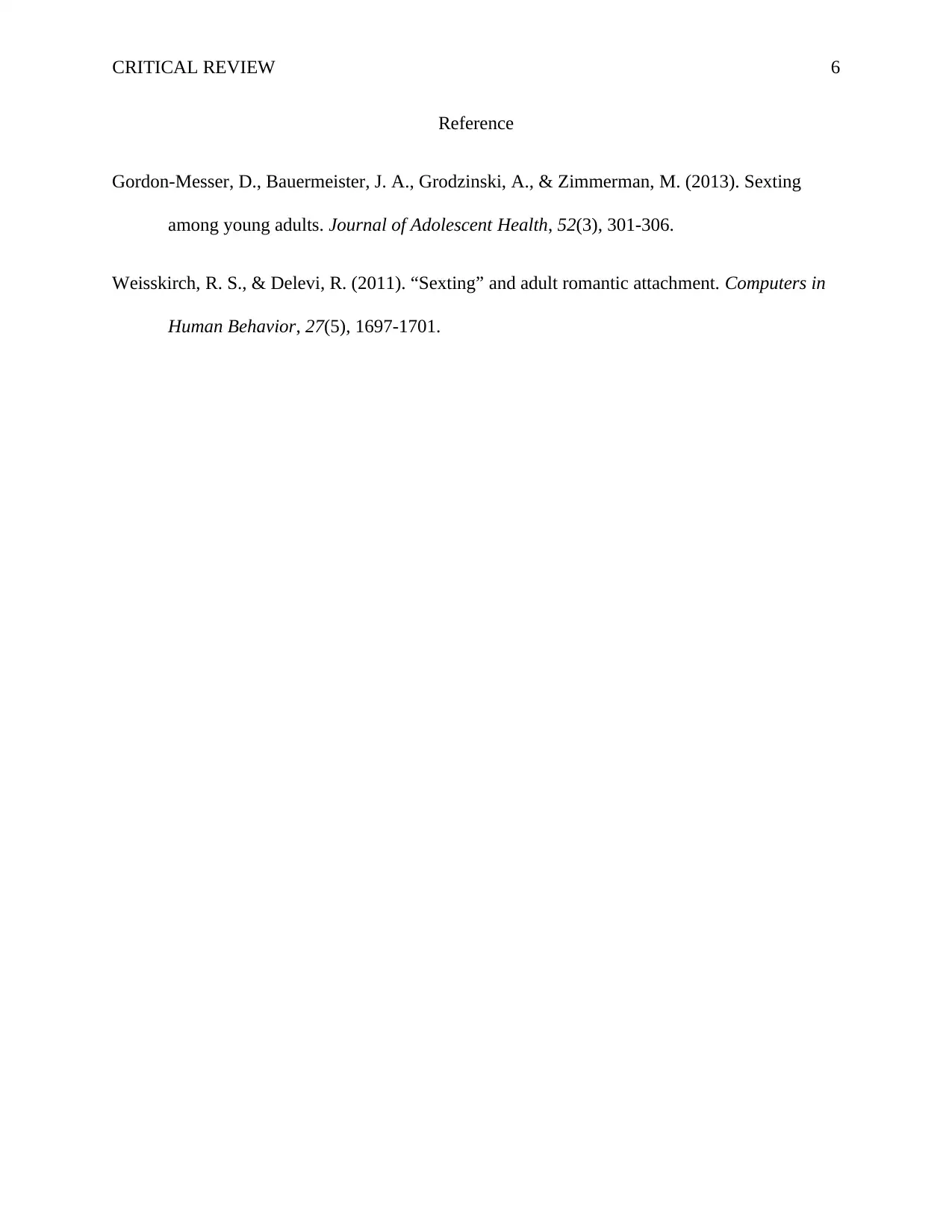
CRITICAL REVIEW 6
Reference
Gordon-Messer, D., Bauermeister, J. A., Grodzinski, A., & Zimmerman, M. (2013). Sexting
among young adults. Journal of Adolescent Health, 52(3), 301-306.
Weisskirch, R. S., & Delevi, R. (2011). “Sexting” and adult romantic attachment. Computers in
Human Behavior, 27(5), 1697-1701.
Reference
Gordon-Messer, D., Bauermeister, J. A., Grodzinski, A., & Zimmerman, M. (2013). Sexting
among young adults. Journal of Adolescent Health, 52(3), 301-306.
Weisskirch, R. S., & Delevi, R. (2011). “Sexting” and adult romantic attachment. Computers in
Human Behavior, 27(5), 1697-1701.
⊘ This is a preview!⊘
Do you want full access?
Subscribe today to unlock all pages.

Trusted by 1+ million students worldwide
1 out of 6
Related Documents
Your All-in-One AI-Powered Toolkit for Academic Success.
+13062052269
info@desklib.com
Available 24*7 on WhatsApp / Email
![[object Object]](/_next/static/media/star-bottom.7253800d.svg)
Unlock your academic potential
Copyright © 2020–2025 A2Z Services. All Rights Reserved. Developed and managed by ZUCOL.





